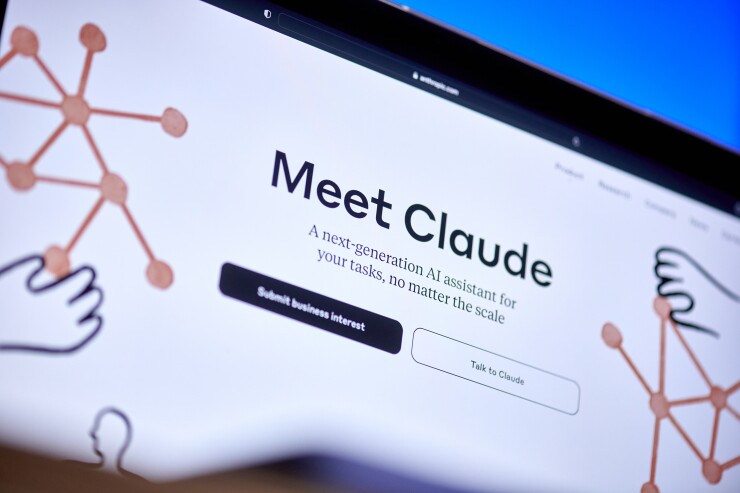
NEW YORK — When Michael Levi leads team meetings at investment firm D.E. Shaw, he makes people do a lightning round of "some strange AI thing you tried in the last week — what worked and what didn't work." Each person gets 30 seconds to share an anecdote, said Levi, who is senior vice president at the firm.
This is one of many tactics leaders at financial companies are using to get employees to use artificial intelligence more often. Levi and others talked about their efforts at Anthropic's launch of Claude for Financial Services in New York this week. The software is a version of the Claude large language model that has been fine-tuned to handle financial analysis and investment research. Through partnerships with Factset, S&P Global, Pitchbook and Morningstar it can tap into market data and research. Bridgewater, Commonwealth Bank of Australia and AIG are among the companies using the new generative AI model.
Large firms like D.E. Shaw and New York Life see AI adoption as part of overall "change management" or "transformation" efforts.
Levi leads a team that works on firm-wide transformation initiatives. "There is no bigger firm-wide challenge and opportunity we're spending time on right now than AI," he said.
At New York Life, "we treat our AI strategy as a portfolio of initiatives," said Don Vu, chief data and analytics officer, who is responsible for AI strategy and execution across the company.
"We started with targeted use cases, specific to workflows of certain business domains, and we had measurable value in production," Vu said. "We realized that we wanted to raise the floor and the ceiling of our aspirations by moving to democratize and empower all of our employees with AI tools."
The firm's business leaders "are looking at each of their respective domains to understand how AI can help us re-anchor our aspirations," Vu continued.
These and other companies are pushing internal AI adoption in several ways. Here are some of the more innovative ideas companies are using to ramp up AI adoption.
Give AI models to everyone
A trend among large banks has been to give large language models to all staff.
"What I would recommend to others is get these tools out there," Levi said. "If your staff says, 'I don't know what to do, I don't know where to start,' tell them to describe their job briefly and ask the AI, how do I start working with this? What are a few things I can try?"
Once colleagues are given tools like Claude and ChatGPT, "they will discover things to do with those that you never imagined," Levi said. "Let people figure out what they do and then pay attention. What we found to be valuable is to encourage folks to come back to it every six months. The degree to which the technology can improve for a particular use case in three months, six months, nine months, can sometimes shock them."
D.E. Shaw monitors employees' usage of Claude. "We're pretty relentlessly data-driven," Levi said. "We look at the usage intensity across the program. You want to encourage people to take more bites of the apple."
Conduct training and hackathons
New York Life has been conducting hands-on training and hackathons to help people in the trenches understand the possibilities of AI, Vu said.
"It really has been kind of a full-court press that's complimented by the top-down commitment from our CEO," he said.
Cyber firms are teaming up with cloud providers to build faster, smarter AI-powered defenses.
Last fall,
Get people to see AI as an assistant
Getting people to use advanced AI requires a change of mindset, Vu pointed out.
"Certainly this is more than just rolling out tools and giving people access," he said. "It's like giving everyone in America a treadmill and expecting heart disease to be cured. What we were very intentional about is understanding that this is actually a mindset shift as well. So I think a lot of people will get a Claude or ChatGPT, they see a text box and think, 'Oh, this is like Google. I should just put in one question and get back an answer, and then I'm done."
In reality, these generative AI assistants are designed to work more like humans, he said.
"This truly is a companion, a copilot, however you might describe it," Vu said. "So having a mindset shift and helping folks understand that, I think, is really incredible."
For instance, when planning a family trip to Costa Rica, "you can go to Google and ask for some recommendations, or you can just prompt Claude or ChatGPT and say, 'Hey, you are the Costa Rica head of tourism. I'm going to Costa Rica with my family of four. My kids are 10 and 12. They like surfing and wildlife. Can you come up with a customized itinerary?' That's a very different paradigm between those two tools. And frankly, for most folks that you know, who first start to engage. We think it's really important to help people on the journey."
Encourage people to use AI in their personal lives
"The route to comfort and learning about how to use these [AI model chatbots] at work doesn't have to only run through work, and often people are more comfortable taking risks in their personal life," Levi said. "It's not as potentially embarrassing, at least in their minds. And so encouraging people to experiment there, I think, can pay off as much or more than encouraging them to take those first jumps at work."
Jonathan Pelosi, enterprise sales leader at Anthropic, said he uses Claude to come up with weekend activities for his two young children. He has also fed doctors' notes into Claude and it's helped him understand a family member's medical condition.
Get HR involved
"One of the things that we've been very intentional about is a relationship with our HR department," Vu said. "Our AI transformation is almost co-led alongside HR. We do really realize the workforce transformation is occurring."
New roles are coming about and new capabilities are required, he said. "With the types of workforce changes that are coming, especially with things like agentic AI, you have to work with your HR partner proactively."






